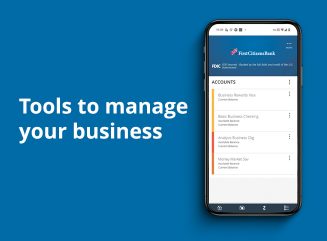Digital banking for business
Seamlessly access all of your accounts from one place with First Citizens Digital Banking for business.

Control your portfolio
Invest how you want, when you want, in real time with Self-Directed Investing.

Digital banking for business
Seamlessly access all of your accounts from one place with First Citizens Digital Banking for business.
See how we're supporting companies
We're committed to serving companies as they expand and succeed. The proof is in our success stories.
Q4 Quarterly Market Review: Available now
The Making Sense team reviews changes in the market during Q4 2025.
While slowdowns in the economy are challenging and have a major impact on small businesses, they don't last forever.

In fact, businesses that survive difficult times frequently emerge stronger than ever with the help of a business recovery plan.
As the economic repercussions of the COVID-19 pandemic became known, reports of business closures spread across the US. While many were in hard-hit industries like travel, tourism and hospitality, manufacturers also struggled as global supply chains dried up.
Despite these hardships, many businesses have continued to survive and even thrive. Common keys to success include the ability to transition to a leaner model, meet changing market demands and focus on service.
Consider the following principles as you plan for the time when economic sluggishness fades and growth returns.
A lull in activity is a great time to revisit the reason why you got into business in the first place—especially if you haven't considered it in a while. Has the business rationale changed? Does it fulfill a new mission or purpose? If so, your employees, customers and prospects will appreciate hearing about this new perspective.
What does your business do well? What's nonessential? By taking an honest look at every aspect of your company, you'll likely find a weak spot or two. For some, it could be a back-office responsibility, such as payroll or HR processes. For others, it could be a supply chain that needs updating or a legacy product that's outlived its value.
Automate your accounting, tap into technology, sharpen your workforce's skill set and streamline as much as possible, conserving resources and positioning yourself to seamlessly scale up the business down the road.
Where's the marketplace headed? Are pandemic-driven trends and changes in customer behavior—such as heightened e-commerce, contactless payments and remote work—likely to stick around? If you believe they will, explore how to make them work best with your business and strengthen your company's digital backbone. Also consider creating a specific plan for business continuity.
Eliminate unnecessary costs. Make tactical investments in upgrades and new equipment while suppliers are hungry for business. Take advantage of lower interest rates to finance strategic acquisitions, refinance older and costlier debt, and build up your cash cushion.
Thanks to social media and email, marketing on a shoestring budget doesn't have to appear desperate. As long as it's done smartly, your target audiences might not even realize you're running lean. The key is to focus on one or two of your strongest social media platforms and deliver relevant content that customers and prospects find valuable on a consistent basis.
To help ensure your business is prepared for the inevitable market shift upward, developing a flexible business recovery plan during challenging times—and enlisting the support of a valuable strategic partner like your business banker—can better position your business for the rebound.



This material is for informational purposes only and is not intended to be an offer, specific investment strategy, recommendation or solicitation to purchase or sell any security or insurance product, and should not be construed as legal, tax or accounting advice. Please consult with your legal or tax advisor regarding the particular facts and circumstances of your situation prior to making any financial decision. While we believe that the information presented is from reliable sources, we do not represent, warrant or guarantee that it is accurate or complete.
Third parties mentioned are not affiliated with First-Citizens Bank & Trust Company.
Links to third-party websites may have a privacy policy different from First Citizens Bank and may provide less security than this website. First Citizens Bank and its affiliates are not responsible for the products, services and content on any third-party website.
First Citizens Bank is a Member FDIC and an Equal Housing Lender icon: sys-ehl.
NMLSR ID 503941

Treasury & Cash Management
Electronic Bill Presentment & Payment
Investment & Retirement Services
Community Association Banking
Equipment Financing & Leasing
Credit Cards
Merchant Services
Email Us
Please select the option that best matches your needs.
Customers with account-related questions who aren't enrolled in Digital Banking or who would prefer to talk with someone can call us directly.